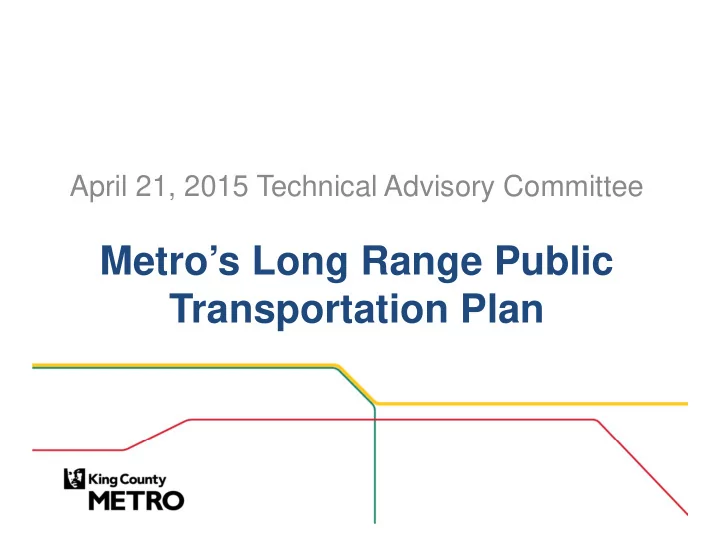

April 21, 2015 Technical Advisory Committee Metro’s Long Range Public Transportation Plan
TAC Overview Tentative Schedule Meeting Topics Why a long range plan February 26 Roles and responsibilities 3:00 ‐ 5:00 p.m. Preparing for upcoming workshop Input on LRP themes Introduce evaluation criteria Workshop to coordinate jurisdiction plans April 21 Draft Network Concepts 2:30–4:30 p.m. Modeling Assumptions Review evaluation criteria Evaluation of Network Concepts June 23 Development of preferred concept 2:30 ‐ 4:30 p.m. Initial evaluation of preferred concept August 20 Direction on concept refinement 2:30–4:30 p.m. 2
Meeting Outline • Review visioning event & Feedback (15 min) • Briefing book review and coordination with Sound Transit (20 min) • Review Long Range Plan Process and Contents (15 min) • Provide input on network concepts and evaluation criteria (60 min) 3
Recent Long Range Plan Activities Formed Advisory Committees/Groups • Technical Advisory Committee • Community Advisory Group Website Survey • 2,600 community members from 38 cities Community Visioning Event • March 31 st –200 people in attendance • Partnering with other stakeholders 4
Public Engagement Overview JAN FEB MAR APR MAY JUN JUL AUG SEP OCT NOV DEC Strategic Engagement Plan - condensed Standing STAKEHOLDER Committee OTREACH Briefings CAG* ADVISORY GROUPS TAC* Website and Develop Maintain ONLINE social media ENGAGEMENT Online Surveys On the ground Fairs and festivals Informational Distribute materials, build and update listserv materials PUBLIC Open Houses/ OUTREACH Community Meetings VISIONING EVENT Community Partner Meetings PHASE DISCOVERY ALTERNATIVES DRAFT *CAG: Community Advisory Group, TAC: Technical Advisory Committee Schedule as of March 9 th 5
Briefing Book Review 6
Population Density 2014 Existing Population Density 2040 Projected Population Density 7
Future Employment Density 2014 Existing Employment Density 2040 Employment Density 8
Transit Supportive Density Change in Transit Supportive Densities in 2040 Combining employment and residential growth, parts of King County will become Transit Supportive by 2040, which could drive future transit investments: • West Seattle • SeaTac • Redmond-Overlake • Kirkland • Beacon Hill 9
Change in Jobs Accessible via Transit in AM Peak– 2014-2040 Change in Jobs Accessible by Transit 2014 ‐ 2040 The number of projected jobs accessible by transit increases in virtually all areas. Even those areas where auto access decreased. 10
What’s in the Plan Service Element • Where our service is going to go • What kind of service it will be Capital Element • What infrastructure we need to make it happen Financial Element • How much it will cost 11
Planning Process Develop and evaluate 3 Initial Concepts • Test different service emphasis, capital infrastructure and integration concepts Initial Concepts to Preferred Concept • Use best parts of 3 Initial Concepts in 1 Preferred Concept Preferred Concept to Final Plan • Finalize capital, financing & phasing 12
Coordinated Transit Planning Adopted Policy Direction Shared Regional Vision 2013 KCM KCM Long Range Strategic Transit Plan Plan Coordinated Transit Planning Getting there together ST ST System Long Range Development Plan – Coordinated public outreach (ST3) Plan – Regional map of integrated future network 2014 – Joint long range planning team – Shared model assumptions 13
Develop Initial Concepts Concept variables Input on Initial Concepts & Evaluation: • Service Emphasis • Meeting with TAC, CAG, • Capital Investments cities, Steering Committee • Sound Transit integration and Metro Staff 14
Draft Initial Concepts FREQUENT EXPRESS/PEAK COVERAGE EXISTING* *Existing frequent and Local Express/Peak Frequent express services do not all meet future standards 15
Evaluation Criteria Topic King County Metro Evaluation Metrics ST Proximity of population to transit stops and P&R’s Access to Proximity of jobs to transit stops Transit Proximity of minority and low-income population to transit How people get to transit stops (car, walking, bike, etc.) Transit Population with convenient access to jobs and school via transit Connections Public transit ridership by type % of travel by transit Countywide Use and Efficiency measures Efficiency Use of transit-priority infrastructure How late or early do the buses run 16
Access to Transit Today Existing Transit Footprint Population w ithin a ¼ mile to ½ mile of a transit stop All Frequent Demographic Group Service Service 68% 40% General population 71% 41% Minority 81% 51% Low-income 17
Projected Transit Access New Population Growth All Stops (1/4 mile) 73% 73% of new 2040 RapidRide or Link (1/2 mile) 32% residents and Combined (1/4 mile for all and 1/2 mile for Link and RR) 76% 79% of new 2040 Frequent Service Combined (1/4 mile for frequent or 53% very frequent, and 1/2 mile for Link and RR) jobs fall within a ¼ New Employment Growth mile of an existing All Stops (1/4 mile) 79% transit stop RapidRide or Link (1/2 mile) 50% Combined (1/4 mile for all and 1/2 mile for Link and RR) 83% Frequent Service Combined (1/4 mile for frequent or 65% very frequent, and 1/2 mile for Link and RR) 18
Jobs Accessible via Transit – 2040 Jobs accessible within 30 minutes via transit is estimated to be highest in: • Downtown Seattle • University District • West Seattle • Downtown Bellevue • Eastgate • Factoria
Draft Initial Concepts FREQUENT EXPRESS/PEAK COVERAGE EXISTING* *Existing frequent and Local Express/Peak Frequent express services do not all meet future standards Do the concepts test the right tradeoffs? 20
Thank You! • Long Range Public Transportation Plan http://www.kcmetrovision.org/ Staff Contacts: Stephen Hunt – Project Manager, KC Metro stephen.hunt@kingcounty.gov 206 ‐ 477 ‐ 5828 Tristan Cook – Community Relations, KC Metro tristan.cook@kingcounty.gov 206 ‐ 477 ‐ 3842 Lisa Shafer – Service Element Lead, KC Metro lisa.shafer@kingcounty.gov 206 ‐ 477 ‐ 5824 21
Recommend
More recommend